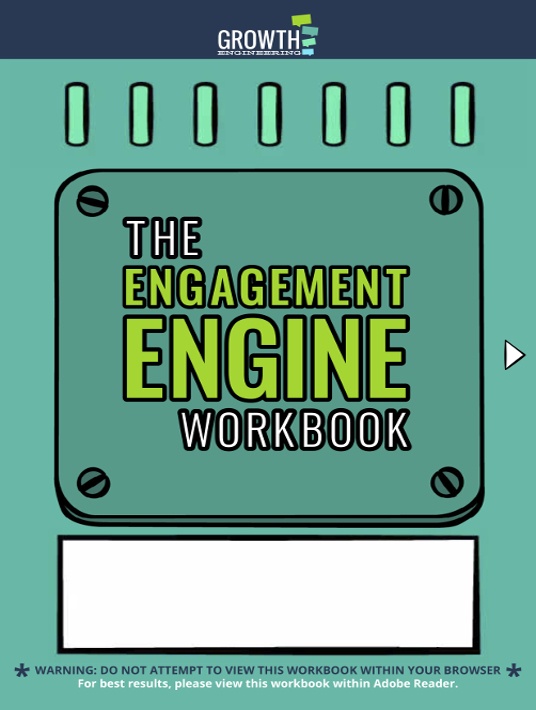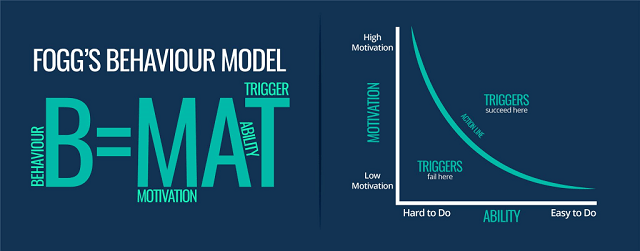How Can We Change Learner Behavior?
BJ Fogg’s Behaviour Model [1] addresses the most significant question in L&D – how can you change behaviour?

This might seem like a huge question, but the purpose of L&D is behaviour change, so it’s worth getting to grips with it. In a world plagued by dull online learning, huge numbers of learners are disengaged. You can hardly expect a disengaged learner to change their ways if they don’t even enjoy their training! But, with Fogg’s Behaviour Model at the ready, you’ll be transforming your organisation and engaging learners in no time!
Who Is BJ Fogg?
BJ Fogg [2] leads the Persuasive Technology Lab at Stanford University. He and his team research human behaviour and how you can influence it to achieve business goals. In fact, he’s been labelled as one of the top ten business gurus of this generation by Fortune magazine [3]. His practical framework will help you transform training into a behavioural change knock-out!
Meet BJ Fogg’s Behaviour Model
Let’s take a look at the model that made Fogg famous:

The equation ‘B=MAT’ rolls of the tongue and sticks in the brain. The concept it communicates is as simple as the equation itself. ‘Behaviour’ is the word Fogg uses to describe an action that someone might do. The question is how can you train employees to do the right actions.
Fogg suggests that three things are needed: motivation, ability, and a trigger. When these three things come together, people are capable of changing the world.
Let’s look at the three components separately:
1. Motivation
Luckily for us, Fogg isn’t talking about your morning cup of coffee. Instead, he’s talking about the underlying drives which motivate you. He highlights three drives, namely sensation, anticipation, and belonging. You can think of motivation as having three distinct levels, a physical level, an emotional level, and a social level.
Sensation
This is the physical level of motivation. Some actions bring us pleasure, whilst other actions cause us pain. We’re motivated to seek pleasure and avoid pain. It’s the pleasure seeker inside everyone that makes gamification so effective. If you offer badges and points when learners change their behaviour, you’ll find their motivation reaches new heights.
Anticipation
This is the emotional level of motivation; specifically, hope and fear. At Growth Engineering, we think hope is the most powerful motivator there is. The absolute best way to use hope as a motivator is to give your learners a sense of Epic Meaning. Epic Meaning taps into the hopes and needs of your learners, particularly the desire be a part of something meaningful. When used effectively Epic Meaning can transform your learners into hope-filled behavioural change champions.
Belonging
This is the social level of motivation, people want to feel like they belong and don’t want to feel rejected. It’s why Superman lives in Metropolis and only visits his Fortress of Solitude for a relaxing weekend break.
It’s for this reason your training needs to be social. If the platform it’s hosted on helps foster a corporate community you’ll find your learners desperate to log in and get stuck in. Use social functionality, like subject-specific forums to harness the power of belonging. When learners belong to a community, they can support each other in their quest for self-betterment.
Making Use Of Motivation
At Growth Engineering we don’t believe in using anything negative to motivate learners. Instead, use gamification to bring them pleasure, Epic Meaning to give them hope, and social functionality to create a sense of belonging. You’ll soon find your learners unleashing their inner learning legend!
2. Ability
Fogg uses the word ability, but it doesn’t just refer to someone’s competence for a particular task. He uses the word to mean how simple it is for someone to do something at a particular moment in time. It’s important to remember that no one does anything they don’t think is worth the effort. Fogg outlines six ways that a task can be made simpler to encourage new behavioural patterns to stick. They are:
Time
Time is precious and no wants to waste it, which is why microlearning makes so much sense. Learners are much more likely to complete a ten-minute unit than a whopping one-hour training monolith. Then, instead of ending the unit on a hefty call to action, try suggesting something manageable. Where you might encourage retail staff to cross-sell as many products as possible, you could specify one product to focus on promoting. This is a clearer, more manageable, and less time-consuming call to action.
Money
Unless you’re Bruce Wayne, you probably watch what you spend. The more money something will cost you, the more motivation you’ll need to do it. For example, if your learners work in a role where they earn commission, any time they spend training is commission lost.
Physical Effort
No one likes doing unnecessary work. Turning on a desktop, logging in, and doing training on a clunky old LMS with no thought for UX is an experience no one should have to endure. Whereas opening an app on your phone is super easy. Make life effortless for your learners and make training mobile!
Thought
Learners are much more likely to do something that doesn’t require much thought. Make sure that your training isn’t unnecessarily complicated and that your call to action at the end is simple and clear. If your learners have to decode your training, you’ll lose them before they can learn anything.
Social Deviance
People don’t like to go against the grain. You might find it easy to turn up to work in your pyjamas, but you wouldn’t do it because that’s not normal. In the same way, if an LMS lacks social functionality then learners might feel like the only one logging in. This is going to put them off, so, make sure to include social functionality like leaderboards and a news feed. This way learners will know they’re part of the pack!
Non-Routine
Everyone has their daily routines. They help people structure their lives, which is why anything that sits outside of a daily routine is much less likely to get done.
Nowadays, mobile phones dictate our routine. Use a mobile training app and send your users notifications. This lets them take their training with them and fit it into their daily routines.
The AWESOME Power Of Simplicity
If learners lack the ability to change their behaviour, the solution might not be more training. It might be to make things simpler. Make the content clearer, the units shorter and as convenient as possible. If learners can do everything you ask of them, you can be sure that you’ll be unleashing superheroes all over your organisation!
3. Triggers
If a learner is raring to do something, and they’re fully able to do it, what happens next? Well… unless you’re very lucky, nothing at all. A learner needs a prompt to spring into action! The final piece of the behavioural puzzle is the trigger.
There are three types of trigger, each aimed at a slightly different audience. They are:
Spark
The spark is a trigger that comes with added motivation. It’s perfect for those who have the ability but lack the motivation. When it comes to training, a spark should help a learner see the Epic Meaning in the behaviour you’re asking of them. They want to know why it’s important, and it’s up to you make them care.
Facilitator
Some learners are bouncing with motivation, but can’t achieve what’s expected of them. To combat this, go micro and send them snippets of training each day. These snippets act as a reminder whilst giving further instruction to help the learner reach the level of ability needed to change their behaviour.
Signal
Some learners are ready to change. They have the motivation, they have the ability, all they need is the starting gun to fire and they’ll get going. Make sure that your training ends with a clear call to action explaining exactly what the learner needs to do.
Final Word
Behaviour change isn’t out of reach. It’s entirely within your grasp. With BJ Fogg’s Behaviour Model as a trusty sidekick, you can ensure long-lasting behaviour change that transforms your organisation.
All you need to do is remember Fogg’s helpful equation: B=MAT. If your learners have the motivation and the ability, all you need is the right trigger. Use gamification, Epic Meaning, and social learning to supercharge your learners’ motivation. Then, remove any barriers to behaviour change, pull the trigger and watch as your organisation transforms.
References:
[1] A Behavior Model for Persuasive Design
[3] 10 new gurus you should know: BJ Fogg









